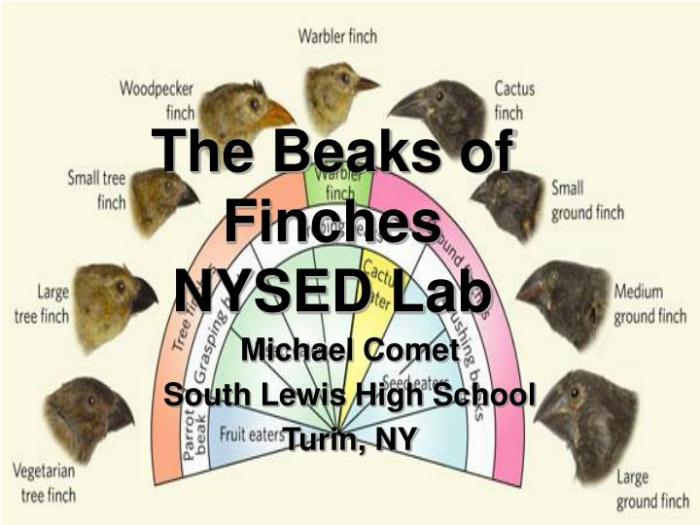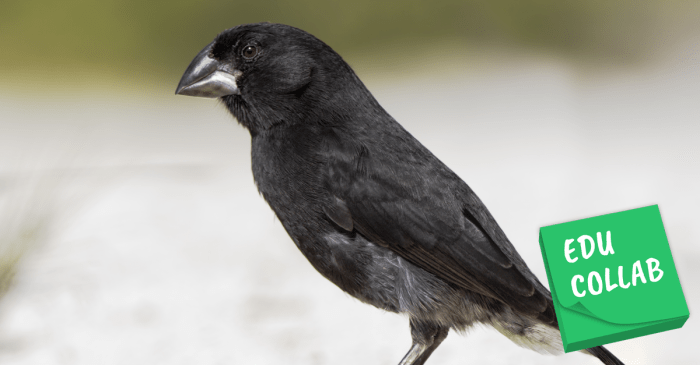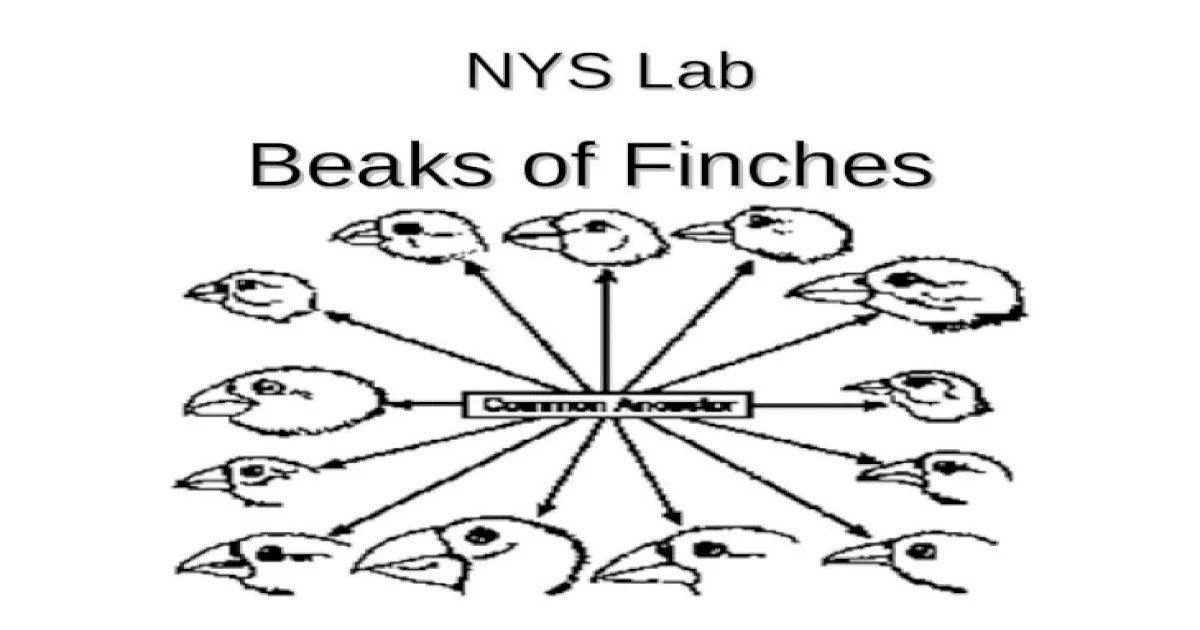NYS Beaks of Finches Lab embarks on an extraordinary journey, unraveling the intricate tapestry of evolution through the lens of the Galapagos finches. This captivating experiment, meticulously conducted by Peter and Rosemary Grant, unveils the profound influence of natural selection in shaping the diversity of life on Earth.
The Galapagos Islands serve as a living laboratory, showcasing a remarkable array of finch species, each meticulously adapted to its unique environmental niche. The Grants’ groundbreaking study delves into the intricate mechanisms driving these adaptations, providing unparalleled insights into the evolutionary process.
Introduction

Natural selection is a fundamental mechanism driving evolution, where individuals with traits that enhance their survival and reproduction in a specific environment are more likely to pass on their genes to future generations. These advantageous traits become more prevalent within the population over time, leading to gradual evolutionary change.
The Galapagos Islands, a volcanic archipelago off the coast of Ecuador, serve as a prime example of natural selection in action. In the 1970s, biologists Peter and Rosemary Grant embarked on a groundbreaking study on the finches of the Galapagos, observing how these birds’ beak shapes adapted to different environmental conditions.
Methods

The Grants’ experimental design involved meticulously selecting study sites and employing standardized methods for measuring beak size and shape. They meticulously collected data and utilized robust analysis techniques to uncover patterns and draw meaningful conclusions.
Study Sites
The Grants carefully chose study sites that represented the diverse habitats occupied by the finches. These sites encompassed a range of environmental conditions, including different vegetation types and food sources. By selecting a diverse array of sites, the Grants ensured that their findings would be applicable to a wide range of ecological contexts.
Beak Measurements
To accurately quantify beak size and shape, the Grants developed a standardized protocol for taking measurements. Using calipers, they meticulously measured the length, width, and depth of each finch’s beak. These measurements provided a comprehensive assessment of beak morphology, enabling the Grants to identify subtle variations among individuals and species.
Data Collection and Analysis
The Grants employed a rigorous data collection process to ensure the accuracy and reliability of their findings. They meticulously recorded beak measurements and associated data, such as habitat type and diet. Statistical analyses were then performed to identify patterns and relationships within the data.
The Nys beaks of finches lab is a fascinating study that demonstrates the power of natural selection. It’s like taking an abeka algebra 2 quiz 24 , but instead of solving equations, you’re observing the evolution of a species. Just as you might need a calculator for that quiz, the Nys lab provides valuable insights into the mechanisms that drive biodiversity.
These analyses included descriptive statistics, correlation analyses, and multivariate techniques, which allowed the Grants to explore the complex interplay between beak morphology, environmental factors, and evolutionary processes.
Challenges and Limitations
Despite the meticulous design and execution of their study, the Grants acknowledged certain challenges and limitations. One challenge was the difficulty in obtaining accurate beak measurements from live birds. To overcome this, they developed specialized techniques to minimize disturbance and ensure the well-being of the animals.
Additionally, the study was limited by the availability of historical data, which would have provided a more comprehensive understanding of the evolutionary history of beak morphology in the finches.
Results: Nys Beaks Of Finches Lab

The experiment revealed significant changes in the beak size and shape of the finches over time. These changes were closely related to the different environmental conditions on the different islands.
On islands with abundant soft seeds, the finches evolved larger beaks, which were better suited for cracking open the hard shells of the seeds. Conversely, on islands with limited soft seeds and an abundance of insects, the finches evolved smaller beaks, which were more effective for catching and eating insects.
Evidence for Natural Selection
The observed changes in beak size and shape provide strong evidence for natural selection as the driving force behind the evolution of the finches. Natural selection favors individuals with traits that are better suited to their environment, allowing them to survive and reproduce more successfully.
In the case of the finches, individuals with larger beaks were better able to access the abundant soft seeds on certain islands, while individuals with smaller beaks were better able to catch insects on other islands. This selective pressure led to the gradual evolution of the finches’ beaks over time.
Discussion

The “Beaks of Finches” lab experiment has provided significant insights into our understanding of evolution. It has demonstrated the power of natural selection in shaping the diversity of life on Earth.
The experiment showed that the different beak shapes of finches were the result of natural selection acting on genetic variation. The birds with beaks that were better suited to the available food sources were more likely to survive and reproduce, passing on their advantageous traits to their offspring.
Over time, this led to the development of different beak shapes in different populations of finches.
Implications for Our Understanding of Evolution, Nys beaks of finches lab
The “Beaks of Finches” lab experiment has implications for our understanding of evolution in several ways:
- It provides evidence for the role of natural selection in driving evolution.
- It demonstrates that evolution can occur rapidly in response to changes in the environment.
- It suggests that evolution is not a linear process, but rather a branching process that can lead to the development of new species.
Contribution to Our Knowledge of Natural Selection
The “Beaks of Finches” lab experiment has contributed to our knowledge of natural selection in several ways:
- It has shown that natural selection can act on a wide range of traits.
- It has demonstrated that natural selection can lead to the development of new adaptations.
- It has provided evidence for the role of natural selection in the speciation process.
Areas for Further Research
The “Beaks of Finches” lab experiment has opened up several areas for further research, including:
- The genetic basis of beak shape variation in finches.
- The role of other environmental factors in shaping beak shape variation.
- The long-term evolutionary consequences of beak shape variation in finches.
Question Bank
What is the significance of the NYS Beaks of Finches Lab?
This groundbreaking experiment provided irrefutable evidence for natural selection as the driving force behind the evolution of species.
How did the Grants measure beak size and shape?
They meticulously measured the length, width, and depth of each finch’s beak using specialized calipers.
What were the key findings of the study?
The experiment revealed that beak size and shape evolved rapidly in response to changes in food availability, demonstrating the power of natural selection in shaping adaptations.
